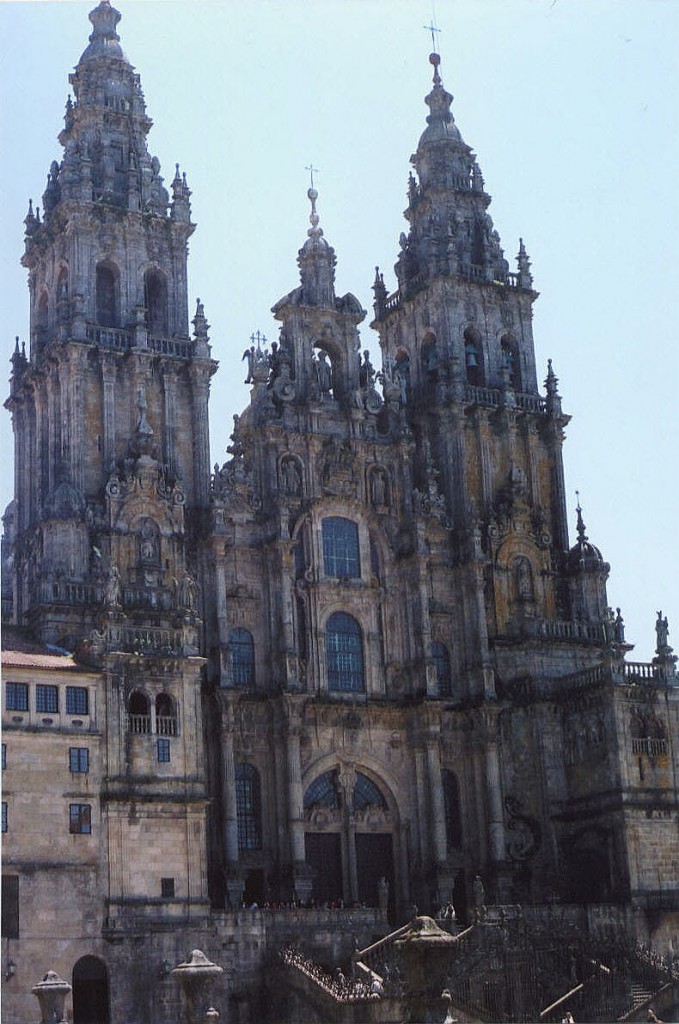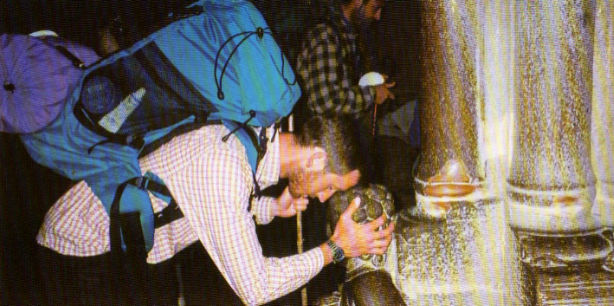Following The Stars To Santiago – Part II
By now, I am well along the way and have come to one of the most meaningful monuments of the walk, “the Iron Cross” in the province of Leon. Each pilgrim continues a thousand-year-old tradition of placing a stone at the foot of this cross. Over the centuries the small mound of stones has become a real mountain that serves as a pedestal for the small iron cross. Each stone is a tribute to a history full of hope and desire. In Roman times, similar mounds where called “hills of Mercury,” the god of pilgrims, and served for territorial demarcation. Centuries afterward, the hermit Glaucoma, protector of the pilgrims in these parts, placed a cross upon these mounds, Christianizing these ancient monuments. The Iron Cross is also a place where pilgrims leave messages for others following along the way.
 After traveling more than 400 miles, one begins to think he has seen everything, but this age-old journey does not cease to surprise, even in its most minute details. I would never have imagined what I came across in a church in the city of Cacabelos: an old and pious image of the Child Jesus playing cards with Saint Anthony of Padua. It was even more surprising to discover that the locals have a very tender devotion to these two illustrious card players. In this same city there is a hospital for pilgrims built in the twelfth century. It presently serves as a restaurant where pilgrims can regain their strength with a delightful meat pie and good wine, completely free of charge. One need only prove that he is truly a pilgrim.
After traveling more than 400 miles, one begins to think he has seen everything, but this age-old journey does not cease to surprise, even in its most minute details. I would never have imagined what I came across in a church in the city of Cacabelos: an old and pious image of the Child Jesus playing cards with Saint Anthony of Padua. It was even more surprising to discover that the locals have a very tender devotion to these two illustrious card players. In this same city there is a hospital for pilgrims built in the twelfth century. It presently serves as a restaurant where pilgrims can regain their strength with a delightful meat pie and good wine, completely free of charge. One need only prove that he is truly a pilgrim.
 The land becomes noticeably greener as one approaches Galicia. The seemingly unending plains are left behind, and nature begins to reward the pilgrim with verdant panoramas. Cebreiro is the first village encountered. The place lies on a plateau almost 4,000 feet above sea level, requiring a long, steep climb to reach it. Frequent rains make the path muddy and the climb all the more difficult. In this small village, where homes are still built in an ancient style using only stone and straw without any sort of mortar, Providence deigned to work an impressive Eucharistic miracle. According to tradition, in the fourteenth century, a tired peasant arrived at the church of Cebreiro to hear Mass. He had come from a little village at the foot of the mountain and had trudged through a strong snowstorm to reach his destination. The monk celebrating the Mass had much less faith than the peasant; scorning the peasant in his heart, he thought him foolish to undergo such hardship to come to Mass. Immediately, the Sacred Species was visibly converted into the Body and Blood of Christ. This Eucharistic miracle is preserved until today in this same church over the tombs of the two anonymous protagonists.
The land becomes noticeably greener as one approaches Galicia. The seemingly unending plains are left behind, and nature begins to reward the pilgrim with verdant panoramas. Cebreiro is the first village encountered. The place lies on a plateau almost 4,000 feet above sea level, requiring a long, steep climb to reach it. Frequent rains make the path muddy and the climb all the more difficult. In this small village, where homes are still built in an ancient style using only stone and straw without any sort of mortar, Providence deigned to work an impressive Eucharistic miracle. According to tradition, in the fourteenth century, a tired peasant arrived at the church of Cebreiro to hear Mass. He had come from a little village at the foot of the mountain and had trudged through a strong snowstorm to reach his destination. The monk celebrating the Mass had much less faith than the peasant; scorning the peasant in his heart, he thought him foolish to undergo such hardship to come to Mass. Immediately, the Sacred Species was visibly converted into the Body and Blood of Christ. This Eucharistic miracle is preserved until today in this same church over the tombs of the two anonymous protagonists.
The Galician landscape is dotted with small villages where life has not changed in many centuries. The fresh aromatic scent of the vast eucalyptus forest reminded me of the Australian bush. The gum trees first came to Galicia last century with the famous Spanish Benedictine missionary Bishop Rosendo Salvado, who had been a zealous apostle among the Aborigine people in Western Australia. One of the few physical consolations of the walk is in the area of gastronomy. A good lunch in one of the typical old inns is just what the body needs to continue. Each region offers its own diversity of impressive products, and it is traditional to stop for the local specialties. The Galician village of Melide, for example, prepares the region’s best octopus. It is hard to fathom how such a delicious dish can be made with an animal that seems so unpleasant.
While one is on the long road of solitude, God whispers special graces into the soul, inspiring good thoughts and new resolutions. Walking all day every day has already become second nature, and one wonders what will happen when, finishing the pilgrimage, he returns to daily life. After following the same path that saints, kings, and souls of Faith have walked for centuries, everything else seems a bit insipid. Then a special emotion sets in as one realizes he will reach Santiago in a matter of days, and Our Lady begins to prepare him spiritually for that moment.
At last, Santiago lay before me. The first view of the towers of the cathedral is from the Mount of Joy, well named for the joy pilgrims experience with their first glimpse of the Shrine. Profoundly moved, I came gradually closer to the city gate. Trying to take advantage of the last remnants of interior solitude, I was unable to speak with the other pilgrims. Tradition dictates that a Holy Year pilgrim to Compostela enter through the Holy Door of the cathedral in order to receive the indulgences granted by the Church. That door, generally closed and barred, is opened only when Saint James’ feast day falls on a Sunday, a tradition dating back many centuries. On the last day of the year preceding a Holy Year, the bishop breaks the seal on the Holy Door with a silver hammer in a ceremony watched with great interest by all Spain. The door then remains open the entire year.
After entering through the Holy Door, one first “hugs” the Saint, represented by a beautiful stone bust over the main altar. Beneath the altar lie the remains of the Apostle, which were rediscovered in 1879 after being hidden from raiding English pirates under Sir Francis Drake 300 years earlier. Mass was being celebrated as I entered the cathedral, and the famous “botafumeiro”— a huge thurible handled by eight men — was swinging from one side of the church to the other, releasing an enormous cloud of incense.
I had finally arrived! The relics of the great Apostle were but a few feet away! Tears flowed down my sunburned face, just like the other pilgrims. The feeling in one’s soul at this moment is very difficult to describe. It can be understood only by one who has carried a pouch on his shoulders along that 550 miles of history toward the field of the star.
Short Stories on Honor, Chivalry, and the World of Nobility—no. 582













